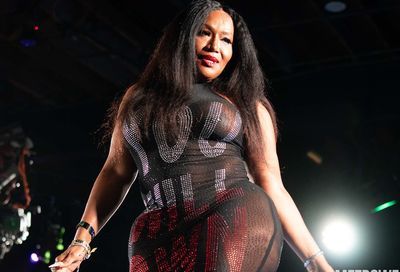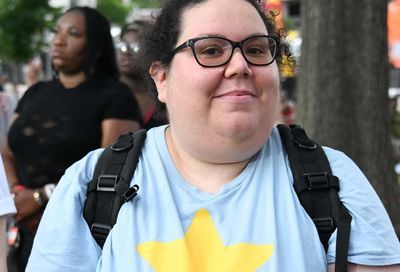Jeff’s Story: One Man’s Experience with Monkeypox
The 35-year-old Maryland resident caught monkeypox after a trip to Europe. He's sharing his story in hopes of raising awareness.

Jeff is not sure exactly when he became infected with monkeypox, but he suspects it may have been while he was visiting Berlin.
“I was going on vacation for two weeks,” says the 35-year-old Baltimore resident. “I was going to be in the United Kingdom, France, the Netherlands, and Germany. Before I left, I’d been seeing a couple of stories pop up here and there on the Internet about monkeypox spreading through Europe. So I asked my doctor if there was a way to get a vaccine before going. And she said, ‘Sorry, We don’t have smallpox vaccine in our little queer clinic in Baltimore yet.’ So I knew the virus existed but didn’t really know much more than that.
“About nine days after I got home, I just had these terrible headaches,” he continues. “I went out to dinner with a friend and it was so bad I left kind of abruptly. It was like, ‘I’ve got to get home.’ I had a bad fever that went up to 102 degrees, which is very high for anyone, but my temperature tends to run on the cooler side. I just thought I had a bit of a bug and took a bunch of NyQuil.
“I woke up the next morning and I felt completely fine. So I kind of went about my life all day Saturday until a friend of mine in Berlin shared with me that he had tested positive for monkeypox. He didn’t infect me, because of the timing. But he was sharing some of his symptoms and some photos of his lesions. And I was like, ‘Well, I don’t have any lesions. So I don’t think that’s what I have.
“The very next day, I started noticing some lesions pop up on my body. They were not painful, and they were not itchy, and my flu symptoms were gone by the time they appeared. So I think that I had a pretty mild case in that regard, but they did last for about three, three-and-a-half weeks, though I was not in a lot of pain.
“Like a lot of other people who’ve had monkeypox, I assume I had lesions in my rectal area just because of the pain I had there. That was the only time that I felt any discomfort at all. There was about a week or so when I would be going to the bathroom when it would hurt and there would be blood.
“But I was lucky to know from my friend who had contracted it in Berlin that part of the disease is having these lesions probably in your butt.
“So I wasn’t too alarmed, even though it hurt and was very unpleasant. I know of other people who had it a lot worse and needed pain meds. I never got to that level, but I developed about 30 to 35 lesions all over my body. They didn’t hurt, but they lasted for a very long time. None of them were regularly itchy. I would just notice them popping up on my body.”
After developing the telltale symptoms of monkeypox in mid-June, Jeff sought help at a local emergency room. The medical staff diagnosed him and discharged him, telling him to isolate at home until all his lesions had scabbed over and fallen off.
“Initially, the lesions just kind of looked like they were weird pimples or warts,” says Jeff, who says some people might understandably confuse the symptoms for another illness or even a sexually-transmitted infection. “When I hear words like ‘lesions’ or ‘sores,’ I kind of imagine this sort of full-body infection, like shingles or something similar. In my case — and in the cases of my friends who’ve gotten it — we all had the same symptoms. But I don’t know if the average person could look at it and say, ‘That’s a monkeypox lesion.
“I think people probably go about their lives for a couple of days without knowing whether they have monkeypox at all,” he adds, which he notes probably facilitates the spread of the disease. “If I hadn’t known what it looked like from my friend’s pictures, the first few days I probably would have been out in the community, because they truly looked like pimples or weird bumps.
“The first bump I noticed came in on my finger and I thought it was a wart,” he continues. “Then the lesions that came next were two on my thighs and one on my leg. The lesions were pus-filled, but unlike a pimple, which you can usually just kind of pop pretty quickly. The first one I saw, I thought it was a pimple. So I kept trying to pop it and it just wasn’t happening. It’s a little harder to the touch, but also hard to puncture. And they were scattered, never clustered all together. It was as if they were all pretty spread out across my body.
“The bump itself is white, it’s kind of puffy with a small ring of redness around it. The one on my finger got huge. But every other one that I had looked like large pimples. Nothing gigantic, not like huge boils. I wish I knew how to measure the size, but they were all relatively small, just numerous. They looked very much like they could be acne or pimples for the first two days. But because of the speed with which they were spreading and the nature of them, I think after a few days, it becomes clear that you have something.”
As the disease ran its course during his three weeks of isolation, Jeff says the lesions began to scab over and fell or peeled off as new skin grew in their place.
“Some of them pop on their own, which results in some scarring. I have a couple of those. But the others that fell off naturally have healed over and there’s barely anything in their place,” he says. “I was pretty good about not picking at them and letting them heal over. While there are about four or five areas where lesions have popped that are still red, I don’t think I’ve got permanent scarring.”
The most difficult part of dealing with the disease, he says, was the isolation.
“It was hard. I missed Baltimore Pride, which was a real bummer. I just sat around the house. I had just gone grocery shopping the day before I went to the E.R., so I had enough groceries for a little while. But it was tough.
“One of the hardest things to contend with were the instructions I received not to ever leave the house. And I live alone,” he continues. “Part of what I was experiencing was because I had registered with the state, someone from the city’s Department of Health, their head of epidemiology, called me every day just to kind of see what was going on.
“While it was very nice to have someone checking in, or someone I could ask questions of every day, I imagine that that is not scalable. One time I said to him, ‘I want to go drive to the county and do a hike.’ And he was like, ‘No, you can’t do that.’ And I was like, ‘Well, I’m not going to see anyone. I’m not going to touch anyone or anything like that. Can I be outside?’ And the Department of Health was really adamant about how it was not okay.
“At the time, which was early on in the first cases, we were getting guidance based on former outbreaks of monkeypox, and they were acting in an abundance of caution, which I understand fully. But at some point, I think there has to be some sort of practical risk assessment. Me going on a walk outside in the woods feels to me like low risk.
“After about two weeks, I did start going on walks in pretty remote areas. I don’t have any outdoor space in my apartment. So I needed to get outside after two weeks of kind of sitting around. I’m lucky that I have a job where I can telework. But there’s only so much you can do in your apartment for two to three weeks.”
While Jeff’s case was less severe than some other monkeypox infections, he understands that others may have a hard time coping with the disease, despite its near-nonexistent fatality rate within the context of the current epidemic.
“I wouldn’t panic a ton, but just keep an eye on your body, and be mindful of what’s happening if you’ve got some spots that you can’t reasonably explain. And if that comes with flu-like symptoms, then take a step back,” he says. “I wouldn’t want the whole world to screech to a halt over this disease.”
With the limited availability of vaccines to treat people both before they become infected or after being exposed, there’s now hope for “bending the curve” on infections.
“My experience is with my personal doctor and the E.R. staff,” says Jeff. “My local health care professionals really treated me well. But I think we’re lacking, in terms of getting the word out and getting vaccines available, or PSAs or any sort of information about what the infection looks and feels like, sort of an ‘If you see these symptoms, stay home.
“It certainly feels like there’s not a large, coordinated effort to let people know what the symptoms are. So I think in that sense, there is a failure,” he concludes. “But personally, I didn’t feel that way, because everyone took really good care of me, and I’m very grateful.”
While monkeypox is not a sexually transmitted disease, it is easily spread through skin-to-skin contact, contact with bodily fluids, or contact with infected items, such as towels or bedsheets.
It is advised that those not in a monogamous relationship who have more than two partners over the span of a 14-day period, or those who believe they had close contact with someone with monkeypox, should get a vaccine as soon as possible.
Support Metro Weekly’s Journalism
These are challenging times for news organizations. And yet it’s crucial we stay active and provide vital resources and information to both our local readers and the world. So won’t you please take a moment and consider supporting Metro Weekly with a membership? For as little as $5 a month, you can help ensure Metro Weekly magazine and MetroWeekly.com remain free, viable resources as we provide the best, most diverse, culturally-resonant LGBTQ coverage in both the D.C. region and around the world. Memberships come with exclusive perks and discounts, your own personal digital delivery of each week’s magazine (and an archive), access to our Member's Lounge when it launches this fall, and exclusive members-only items like Metro Weekly Membership Mugs and Tote Bags! Check out all our membership levels here and please join us today!

























You must be logged in to post a comment.